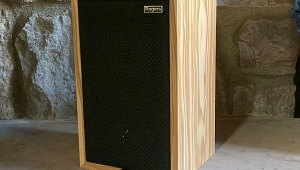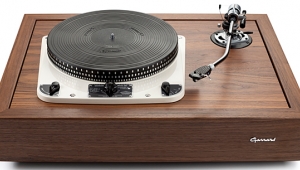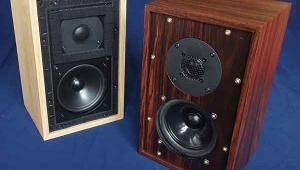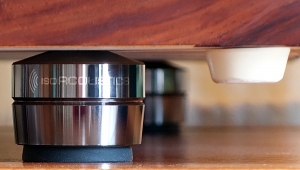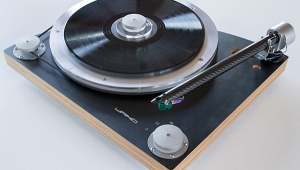| Columns Retired Columns & Blogs |
Listening #24
You dodged a bullet.
My first idea was to open this column with a thinly veiled rewrite of O. Henry's "The Gift of the Magi," the story in which Jim sells his watch so he can buy a set of tortoiseshell combs for Della, and Della sells her hair so she can buy a watch fob for Jim, and blah blah blee. I would have brought it up to date, of course, not only because it lacks some relevance in its original form—curiously, no one stands in line to buy hair from strangers anymore—but because I get enough grief as it is from angry men who don't like it when I write about things other than audio hardware.
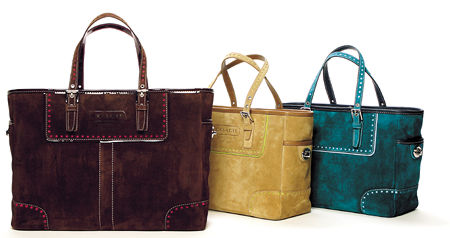
But I decided to abandon all attempts to entertain myself and my editor at your expense and cut to the chase: Christmas is coming. And if you're expecting a present, you might as well make sure you get what you want, if not what you deserve. (Some of you have been very naughty. Still, a sneezing leper is hard to wrap.)
Most of you guys are guys. And most of the people in a position to give you something of value are women. I'm on your side in this, of course, and I want you to have something nice—but the gal in your life can't get you something nice without a bit of direction. So when I submitted this column to Stereophile, I also gave them very specific instructions regarding the artwork to print alongside it. All you have to do is place this issue next to a potted plant or a housecat, open to this page, and I promise that my clever use of art direction will grab the attention of any female within a two-mile radius, and will pull them in like a sticky vacuum-powered magnet.
Don't thank me. That's the sort of professionalism I'm paid for.
Great Gifts under $1,000,000,000
First, you can't expect your non-audiophile lover to buy you a new preamp, amp, speakers, or other such major components. That would be crazy. They have no idea what you want, partly because they don't really care, and partly because you probably change your mind about it more or less hourly. Besides, you shouldn't wish for such expensive gifts. Shame on you.
I also can't make those sorts of recommendations for the simple reason that I don't know what you already have in your system. You may already own "the best" of everything. (Yeah, and maybe you snuck that $50,000 tube amp into the house by convincing your wife you found it at the curb on garbage day with a Free Puppy sign on it: God knows some of them look the part.)
The only exceptions to that rule would be products that can be expected to improve any system—and that mythic category is more or less limited to source components, which tend to influence more than interact, if you catch my meaning.
But even that's fuzzy, isn't it? Fifteen years ago I would have said that a Linn LP12 turntable fitted with an Ekos tonearm and Troika cartridge could improve any system that didn't already have one—which was almost certainly true. Today there are other, equally good choices of record player—yet, at the same time, there's a good chance that the audiophile who isn't already into analog isn't really interested in same, for reasons of unavailability. Whether or not that's a reasonable point of view, I'm in no position to presume to change minds—so I'll make a few relatively limited source-component suggestions instead.
For the audiophile who hasn't already made the LP plunge but is interested in doing so, a semi-turnkey package such as the Rega P3 'table with Rega RB300 arm ($695) is almost always a solid choice. It's a durable, good-looking thing, and it provides at least three-quarters of what's special about vinyl in the first place. It's also a splendid value, given that its standard tonearm continues to embarrass so much of the pricier competition.
Still, if more money wishes to be spent, then consider the superb VPI Scout turntable with VPI JMW-9 tonearm, which sell for $1600 when purchased together. With just a bit of digging, you can find a dealer who'll add the very, very complementary Ortofon Kontrapunkt A cartridge to the VPI package, for a total price of around $2000. That combination is every bit as musical as the Rega, but with more in the way of musical color, drama, and overall bigness of sound.
Can I bring myself to recommend a CD player for that rare person who still listens only to LPs? I suppose so—although it gives me the same feelings as a dad who celebrates a teenage son's coming of age by bringing him to his favorite prostitute: a weird combination of guilt, pride, distaste, and a pink feeling of inevitability.
If you can get past all that, then a Rega Planet 2000 CD player ($995) would be a fine thing for anyone to have in their music system. So would the even pacier and smoother Naim CD5i ($1650). Then again, my recommendation to such a person might also be to sidestep CDs altogether and start getting your digital music kicks with an Apple iPod ($499). Assuming you love music and don't already own an iPod, and assuming you deserve a $499 present, you should ask for one of those. Even if Apple's technology is surpassed in the near future—which is, of course, a sure thing—downloading remains the manner in which we will get most of our music in the years to come. It's like buying a Model T in 1909: Better cars are coming, but not better horses. Now's the time to learn how to drive.
Great Gifts under $300
Buying an isolation platform for an audio component used to be easy. [Insert cranky old man sounds here: clearing of throat, shifting of weight in expensive leather armchair, etc.] When I was young, we had the Mission Isoplat—which was, I believe, the first audio product to use Sorbothane feet—and at least half the things I put on the Isoplat sounded better that way. After the Mission came the Base, which was, in a sense, an updated Isoplat. I still have mine, and some things—my EAR 890 amplifier, for instance—sound better on the Base than on anything else. But before I met the genuinely nice people of Gingko Audio at Home Entertainment 2004 East last June, I had no idea anyone still made isolation platforms that are this simple, this attractive, and this reasonably priced.
The Gingko Cloud 10 is supplied as two sheets of acrylic—a lower platform that's made with a series of round indentations, and a skirted upper platform—between which the user places three or more rubber balls (four are supplied as standard). The number and positions of the balls can be altered to suit a range of component weights, and can even be adjusted to compensate for a product whose weight distribution is less than perfect—say, perhaps, an amplifier with very heavy transformers at the back, but not a whole lot at the front.
- Log in or register to post comments


